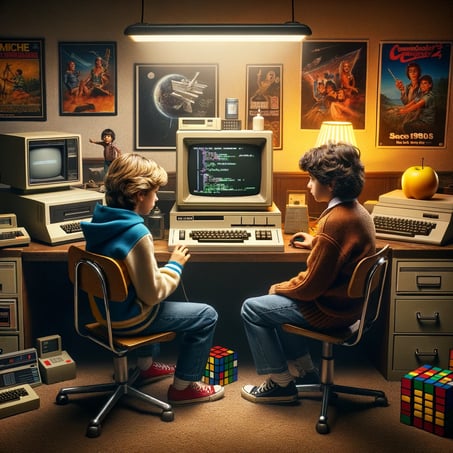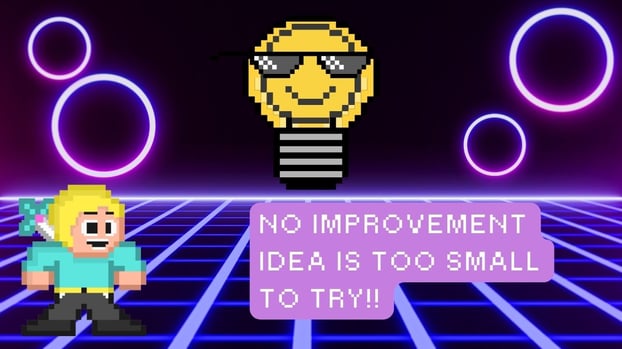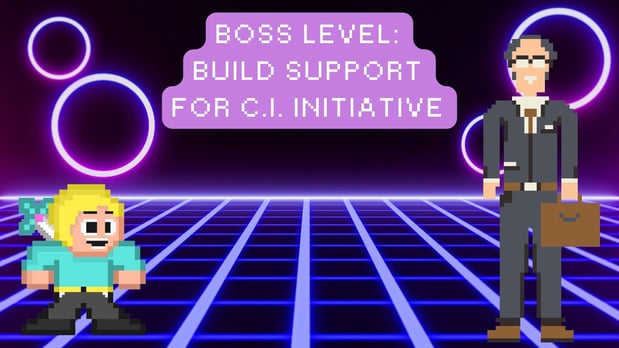In their quaint unsuspecting neighborhood of the 1980s, two young visionaries, Greg Jacobson and Matt Paliulis, embarked on an adventure that would unknowingly pave the way for a future innovation. While their peers were preoccupied with the latest Atari games and BMX bikes, Greg and Matt found themselves enthralled by a different kind of challenge: optimizing their paper routes through the principles of Kaizen, a concept they barely understood but inherently practiced. They were natural Kaizen thinkers.
Greg and Matt were able to, through Kaizen, complete their routes in half the time and with 100% delivery accuracy. They optimized the paths of their routes. They customized their bikes and made small improvements to their delivery bags, sharing the results of their experiments with each other freely. They weren't competitors, they were friends and colleagues.
What would they do with the extra time and the money they made from their route? They bought an Apple IIe computer and taught themselves how to write programs.
Here's a photo of them hard at work in the late 80s, courtesy of Greg's parents.

The Original Video Game
A groundbreaking idea was born - the game was named "KaiNexus: The Quest for Continuous Improvement." Unlike any other game of its time, it featured a protagonist not wielding swords or casting spells, but a paperboy with the power to transform the mundane into the magnificent. It was a journey fueled by the spirit of kaizen and a quest for operational excellence.
The game was long lost, buried away digitally on 5 1/4" floppy disks. Thankfully, KaiNexus chief architect Adam Hamed found an old Apple computer at a relative's house. Being the tech whiz that he is, he cobbled together an adapter from the Apple disk drive cable to a USB-C plug. Quickly building an Apple IIe emulator, Greg and Matt were able to view and play their game once again at the KaiNexus office.
Here is a video that shows the initial launch screen and some other promotional highlights for the game:
In "KaiNexus: The Quest for Continuous Improvement," players were transported to the magical land of KaiNexus. This was no ordinary world, but a place where inefficiencies were dragons to be slain and operational excellence the highest honor. The paperboy, an unsuspecting hero, finds himself imbued with the power to see the potential for improvement in everything, turning his paper route into a thrilling quest for efficiency and effectiveness.
Ofie's First Appearance!
Armed with the "Scrolls of Kaizen," players navigated through the enchanting land of KaiNexus, facing challenges and puzzles that taught the principles of continuous improvement. Each level was designed so that Ofie, a talking incandescent lightbulb, could talk (through text on screen) and impart wisdom to the players about reducing waste, streamlining processes, and enhancing quality, with the paperboy growing stronger with every inefficiency eradicated.
Two such examples of Ofie's wisdom:

.jpg?width=629&height=354&name=KAINEXUS%20VIDEO%20GAME%2080S%20(1).jpg)
Players progressed through multiple levels of the game:
-
Wasteland of Overproduction - Players must navigate through a cluttered landscape, finding ways to streamline production and eliminate excess without compromising quality.
-
The Cave of Corrections - This level challenges players to identify and correct errors in a complex system, using feedback loops and root cause analysis to prevent future mistakes.
-
Inventory Isles - A series of interconnected islands where players must balance resource levels, avoiding both shortages and surpluses to meet the demands of the realm.
-
The Maze of Motion - A labyrinthine factory where unnecessary movement is the enemy. Players must redesign the layout to minimize movement and increase efficiency.
-
Valley of Defects - In this valley, players encounter products with various defects. They must implement quality control measures and continuous improvement processes to enhance product quality.
-
The Mountain of Overburden - Climbing the mountain requires players to balance workloads and implement ergonomic solutions to prevent overburdening and ensure the well-being of their team.
-
The Stream of Flow - A fast-moving stream where players need to manage the flow of materials and information to ensure smooth and uninterrupted operations. Avoid those rocks!!
-
The Forest of Waiting - A dense forest where delays and downtime lurk behind every tree. Players must optimize processes to reduce waiting times and increase productivity.
-
The Bridge of Bottlenecks - Crossing this bridge requires players to identify and alleviate bottlenecks, ensuring a balanced and efficient flow of operations.
-
Castle of Continuous Improvement - The final level, where players must apply all the lessons learned to transform an old, inefficient castle into a model of operational excellence, demonstrating mastery over the principles of Kaizen.
Each level not only tests players' skills and understanding of continuous improvement principles but also immerses them in an engaging story that makes learning fun and memorable.
In the final Boss Mode level, players were given the challenge of convincing the Big Boss about the power and benefits of Kaizen. But if you followed Ofie's advice about tabulating the results and benefits of your improvements, you were sure to win.

The magic of "KaiNexus: The Quest for Continuous Improvement" was not just in its gameplay but in its ability to inspire. Printed on the pages of the game's manual, now a collector's item, were the seeds of what would become a real-world revolution. The principles of Kaizen, once confined to the screens of an Apple IIe, would lay the foundation for the KaiNexus enterprise software that first became available in 2010.
Fast Forward to Today - Enterprise Software
Fast forward to the modern era, and the fantasy of KaiNexus has become a reality. Greg and Matt, reflecting on their childhood creation, realized the game’s deeper significance. The magical land of KaiNexus was more than just a fictional world; it was a blueprint for a platform that could transform organizations by harnessing the collective power of employees to drive improvement.
Today, KaiNexus stands as a monument to innovation, a platform that encapsulates the essence of "KaiNexus: The Quest for Continuous Improvement." It is a testament to the idea that within every task, no matter how mundane, lies the potential for magic and improvement. Well, it's not magic. It's the combination of the right methodologies, management mindsets, and technologies. You don't have to be transported to a faraway magical land—you can cultivate a culture of continuous improvement wherever you work, today!
A Review of the Game from 1989
Thanks to some clever internet searching, Danielle Yoon, our marketing manager at KaiNexus, found this review from a 1989 computer magazine that's long defunct.
ByteScape Magazine Review: "KaiNexus: The Quest for Continuous Improvement" - A Misguided Adventure? (★★☆☆☆)
In the era of high-flying adventures like "The Legend of Zelda" and pulse-pounding action of "Contra," a peculiar new title has emerged from the depths of the software world, daring to defy the conventions of 1989's gaming culture. "KaiNexus: The Quest for Continuous Improvement" attempts to merge the thrill of video gaming with the... thrill of operational efficiency? This title, however, lands in our review section with an underwhelming 2 stars out of 5, and here's why.
Upon booting up "KaiNexus" on our trusty Commodore 64, we were greeted not with the promise of adventure or the allure of mystery, but with the task of optimizing paper routes through the lens of kaizen - a term more familiar to our parents in their workplaces than to us in our gaming dens. The game's hero, a paperboy tasked with the monumental challenge of transforming the land of KaiNexus through continuous improvement, left us more puzzled than intrigued.
As we navigated through levels like the "Inventory Isles" and "The Forest of Waiting," the realization dawned that we were essentially playing a game designed around the principles of efficiency and waste reduction - a concept that might have our economics teacher nodding in approval but had us yearning for the days of "Space Invaders."
The game's attempt to gamify the concepts of Japanese management principles and continuous improvement is, admittedly, an innovative approach. Yet, one can't help but feel that "KaiNexus" misses the mark on what makes gaming an escape for many of us. The graphics and soundtrack do little to elevate the game beyond its core educational intent.
It's not all doom and gloom, though. "KaiNexus" could very well be a glimpse into the future, a pioneer in the genre of educational gaming that might find its audience in the next century. Perhaps in the year 2010, when corporate efficiency and lean management principles are the bread and butter of every school curriculum (and organization), "KaiNexus" will be hailed as a classic that was simply ahead of its time.
For now, however, we find ourselves caught between the game's noble educational intentions and the reality of what makes a game truly entertaining. "KaiNexus: The Quest for Continuous Improvement" ventures boldly where no game has gone before, but unfortunately, it does so without the one thing we crave the most - fun.
In summary, while "KaiNexus" may one day be regarded as a pioneering effort in blending learning with play, its current appeal is limited. It serves as a stark reminder that the heart of gaming lies in adventure, excitement, and escapism, not in the optimization of virtual paper routes. As we look to the future, we remain hopeful that games will continue to inspire, entertain, and, yes, occasionally educate, but always with the player's enjoyment as the top priority.
What Do You Think?
Did you ever get to play the KaiNexus game in 1989? We'd love to hear what you think. Should we incorporate the game into our KaiNexus platform this year? Stay tuned...


Add a Comment